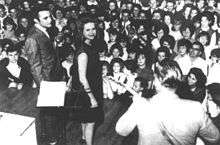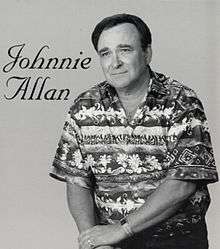Swamp pop
| Swamp pop | |
|---|---|
| Stylistic origins | |
| Cultural origins | 1950s; Acadiana region |
| Typical instruments | |
Swamp pop is a musical genre indigenous to the Acadiana region of south Louisiana and an adjoining section of southeast Texas. Created in the 1950s and early 1960s by teenaged Cajuns, it combines New Orleans-style rhythm and blues, country and western, and traditional French Louisiana musical influences. Although a fairly obscure genre, swamp pop maintains a large audience in its south Louisiana and southeast Texas homeland, and it has acquired a small but passionate cult following in the United Kingdom, northern Europe, and Japan.[1]
It is not to be confused with "swamp rock" (such as the work of Creedence Clearwater Revival and Tony Joe White), which is a distinct genre that drew more on 1960s rock than on the 1950s rhythm and blues sound that helped to define swamp pop.
The sound

The swamp pop sound is typified by highly emotional, lovelorn lyrics, tripleting honky-tonk pianos, undulating bass lines, bellowing horn sections and a strong rhythm and blues backbeat. It is exemplified by slow ballads like Cookie and the Cupcakes' "Mathilda" (recorded 1958), considered by many fans as the unofficial swamp pop "anthem". But the genre has also produced many upbeat compositions, such as Bobby Charles' "Later Alligator" (1955), popularly covered by Bill Haley & His Comets.[2]
During the genre's heyday (1958-1964), several swamp pop songs appeared on national U.S. record charts. These included Jimmy Clanton's "Just A Dream" (1958), Warren Storm's "Prisoner's Song" (1958), Phil Phillips' "Sea Of Love" (1959), Rod Bernard's "This Should Go On Forever" (1959), Joe Barry's "I'm A Fool To Care" (1960), and Dale and Grace's "I'm Leaving It Up To You" (1963).[3]
In swamp pop's south Louisiana-southeast Texas birthplace, fans regarded many songs that never became national hits as classics. These include Johnnie Allan's "Lonely Days, Lonely Nights" (1958), Buck Rogers' "Crazy Baby" (1959), Randy and the Rockets' "Let's Do the Cajun Twist" (1962), T. K. Hulin's "I'm Not a Fool Anymore" (1963), and Clint West's "Big Blue Diamond" (1965), among numerous others.[4]
Roots and early history
As children, swamp pop musicians listened to (and often performed) traditional Cajun music and black Creole (zydeco) music, as well as popular country and western (hillbilly) songs by musicians like Bob Wills, Moon Mullican and Hank Williams In the mid-1950s, however, like other American youths, they discovered the alluring new sounds of rock and roll and rhythm and blues artists like Elvis Presley and Fats Domino. As a result, these teenaged Cajuns and black Creoles stopped playing Louisiana French folk compositions like "Jolie Blonde", "Allons a Lafayette", and "Les flammes d'enfer" and instead began to sing rock and roll and rhythm and blues compositions in English. At the same time, they switched from folk instruments like the accordion, fiddle, and iron triangle to modern instruments, such as the electric guitar and bass, upright piano, saxophone, and drumming trap set.[5]

By the late 1950s, swamp pop musicians had developed their own distinct sound and repertoires. They performed to receptive crowds in local dancehalls like the Southern Club in Opelousas, Landry's Palladium in Lafayette, the OST Club in Rayne, and the Green Lantern in Lawtell. In addition, they released recordings on local record labels, such as Floyd Soileau's Jin label of Ville Platte, Eddie Shuler's Goldband of Lake Charles, Carol Rachou's La Louisianne of Lafayette, Huey Meaux's Crazy Cajun label of Houston, and a number of labels owned by J. D. Miller of Crowley, Louisiana (who also recorded swamp pop tunes for larger national labels, such as Ernie Young's Excello Records label of Nashville).[6]
Swamp pop musicians often adopted Anglo-American stage names that masked their Cajun surnames. John Allen Guillot, for example, became Johnnie Allan; Robert Charles Guidry became Bobby Charles; Joe Barrios became Joe Barry; Elwood Dugas became Bobby Page; and Terry Gene DeRouen became Gene Terry. Some of these musicians changed their names because they were ashamed of their rural French heritage — a feeling shared at the time by a segment of the Cajun population. But economics motivated most swamp pop musicians: They wanted to sell records not only in southern Louisiana and southeast Texas, but beyond, where the pronunciation of ethnic surnames like Guillot, Barrios, and DeRouen eluded record promoters, disc jockeys, and consumers.[7]
Despite its obvious rock and roll and rhythm & blues influences, swamp pop was not devoid of folk characteristics. For example, Bobby Page and the Riff Raffs recorded "Hippy-Ti-Yo", a bilingual rock and roll version of the traditional Cajun French song "Hip et Taiaut" and Rod Bernard did the same with "Allons danser Colinda", another important folk composition. Joe Barry re-recorded his swamp pop hit "I'm A Fool To Care" in French under the title "Je suis bête pour t'aimer". And Randy and the Rockets issued "Let's Do The Cajun Twist", an English remake of the Cajun French favorite "Allons a Lafayette".[8]
Legacy

Since the genre's origin in the mid-1950s, over 20 swamp pop songs have appeared in the Billboard Hot 100. Five of these songs broke into the Top 10, and three of them reached number one. While swamp pop drew heavily on New Orleans rhythm and blues, it reciprocated by making a detectable impact on songs like Lloyd Price's "Just Because", Earl King's "Those Lonely Lonely Nights", Little Richard's "Can't Believe You Want To Leave" and "Send Me Some Lovin'", and Clarence "Frogman" Henry's "(I Don't Know Why) But I Do" and "On Bended Knee" (both Bobby Charles compositions). Swamp pop also left its imprint on the related but distinct genre known as "swamp blues", including Slim Harpo's classic "Rainin' In My Heart". Jerry Lee Lewis recorded many swamp blues/swamp pop type songs most notably the Cookie and the Cupcakes hit "Mathilda", Harpo's "Rainin' in my heart" and a version of the blues standard "Got you on my mind" that is probably based on the Cookie interpretation.
Swamp pop's impact on popular music is heard in the Rolling Stones' cover of Barbara Lynn's "You'll Lose a Good Thing" and "Oh Baby (We Got A Good Thing Goin')", the Honeydrippers' rendition of Phil Phillips' "Sea of Love", the Bee Gees' own "Lay It On Me", Elvis Presley's remake of Johnny Ace's "Pledging My Love", and even The Beatles' swamp-inspired "Oh! Darling".
The work of Creedence Clearwater Revival and Tony Joe White is sometimes referred to as "swamp rock",[9] which is a distinct genre that drew more on 1960s rock than on the 1950s rhythm and blues sound that helped to define swamp pop.[10]
Swamp pop influenced Tex-Mex music, particularly the recordings of Freddy Fender's early swampy songs like "Before The Next Teardrop Falls" and "Wasted Days and Wasted Nights" in 1975. (South Louisiana and southeast Texas audiences generally consider Fender a full-fledged swamp pop musician.)[11]
Although the genre began a slow decline with the onslaught of the British Invasion, swamp pop music continues to draw devoted fans to south Louisiana and southeast Texas festivals and nightclubs. Only a few younger swamp pop musicians, such as Don Rich, are replacing the original generation of swamp pop pioneers, most now in their sixties. Some younger non-swamp musicians, such as Cajun musician Zachary Richard and rockers Marc Broussard and C. C. Adcock, have acknowledged a strong swamp pop influence. (Adcock co-produced a documentary, released in 2009, titled Promised Land: A Swamp Pop Journey, which focused on his swamp pop supergroup Lil' Band o' Gold; this group features swamp pop pioneer Warren Storm on drums and guest vocals by Tommy McLain).
Selected discography
- Johnnie Allan, Promised Land, Ace 380, 1992 [UK].
- Johnnie Allan, Swamp Pop Legend: Johnnie Allan – The Essential Collection, Jin 9044, 1995.
- Rod Bernard, Swamp Pop Legend: Rod Bernard – The Essential Collection, Jin 9056, 1998.
- Rod Bernard, Swamp Rock 'n' Roller, Ace 488, 1994 [UK].
- The Boogie Kings, Swamp Boogie Blues, Jin 9045, 1995.
- Van Broussard, The Early Years, CSP 1007, 1993.
- Bobby Charles, Bobby Charles, 1971
- Cookie & The Cupcakes, By Request, Jin 9037, 1993.
- Clarence 'Frogman' Henry, But I Do (EP) 1961.
- Dale Hawkins, Susie Q (EP), Checker 1957
- Charles Mann, Swamp Pop Legend: Charles Mann – The Essential Collection, Jin 9060, 1998.
- Randy & The Rockets, A Blast from the Past – The Essential Collection, Jin 9059, 1998.
- Phil Phillips, Sea of Love, (EP) Mercury, 1959.
- Phil Phillips, Sea of Love, (Album) Bear Family, 2008.
- Warren Storm, Night After Night, Jin 9039, 1995.
- Tommy McLain, Swamp Pop Legend: Tommy McLain – The Essential Collection, Jin 9054, 1997.
- Slim Harpo, Raining in My Heart, Excello, 1961.
- Clint West, Swamp Pop Legend: Clint West – The Essential Collection, Jin 9055, 1997.
- The Uniques (Louisiana Band), Don't Miss Your Water
- Various Artists, Eddie's House of Hits: The Story of Goldband Records, Ace 424, 1992 [UK].
- Various Artists, Swamp Gold, Vol. 1 - Vol.8, Jin (1991-2006).
Footnotes
- ↑ Shane K. Bernard, Swamp Pop: Cajun and Creole Rhythm and Blues (Jackson, Miss.: University Press of Mississippi, 1996), pp. 5-6, 44.
- ↑ Bernard, Swamp Pop, pp. 5-6, 25.
- ↑ John Broven, South to Louisiana: Music of the Cajun Bayous (Gretna, La.: Pelican, 1983), pp. 179-83.
- ↑ Bernard, Swamp Pop, p. 6.
- ↑ Bernard, Swamp Pop, pp. 18-19.
- ↑ Bernard, Swamp Pop, pp. 104-8.
- ↑ Bernard, Swamp Pop, pp. 60-62.
- ↑ Bernard, Swamp Pop, pp. 84-86.
- ↑ L. C. Hillstrom, The Vietnam Experience: a Concise Encyclopedia of American Literature, Songs, and Films (Greenwood, 1998), p. 115.
- ↑ Bernard, Swamp Pop, p. 106.
- ↑ Bernard, Swamp Pop, pp. 64-65, 106-07.
References
- Shane K. Bernard, Swamp Pop: Cajun and Creole Rhythm and Blues (Jackson: University Press of Mississippi, 1996).
- John Broven, South to Louisiana: The Music of the Cajun Bayous (Gretna, La.: Pelican, 1983).
- Ryan A. Brasseaux & Kevin S. Fontenot, Accordions, Fiddles, Two-Step & Swing: A Cajun Music Reader (Lafayette, La.: Center for Louisiana Studies, 2006).